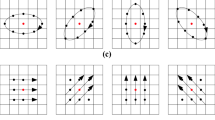Abstract
In this paper, a new Gradient Gabor (GGabor) filter is proposed to extract multi-scale and multi-orientation features to represent and classify faces. Gradient Gabor filters combine the derivative of Gaussian functions and the harmonic functions to capture the features in both spatial and frequency domains to deliver orientation and scale information. The spatial positions are encoded through using Gaussian derivatives which allow it to provide more stable information. An Efficient Kernel Fisher analysis method is proposed to find multiple subspaces based on both GGabor magnitude and phase features, which is a local kernel mapping method to capture the structure information in faces. The experiments on two face databases, FRGC version 1 and FRGC version 2, are conducted to compare performances of the Gabor and GGabor features. The experiment results show that GGabor yield a powerful tool to model faces, and the Efficient Kernel Fisher classifier can improve the efficiency of the original Kernel Fisher Discriminant analysis method.





Similar content being viewed by others
References
Leonardis A, Bischof H (2000) Robust recognition using eigenimages. Comput Vis Image Underst 78(1):99–118
Moeslund TB, Granum E (2001) A survey of computer vision-based human motion capture. Comput Vis Image Underst 81(3):231–268
Marr D, Hildreth E (1980) Theory of edge detection. Proc Royal Soc London 207:187–217
Freeman WT, Adelson EH (1991) The design and use of steerable filters. IEEE Trans Pattern Anal Mach Intell 891–906
Gabor D (1946) Theory of communication. J Inst Electrical Eng 93(26):429–457
Zhang X, Jia Y (2006) Local steerable phase (LSP) feature for face representation and recognition. Proc IEEE Comput Soc Conf Comput Vis Pattern Recognit 2:1363–1368
Ahonen T, Hadid A, Pietikainen M (2006) Face description with local binary pattern: application to face recognition. IEEE Trans Pattern Anal Mach Intell 28(12):2041–2307
Li Y, Zhang B, Shan S, Chen X, Gao W (2006) Bagging based Efficient Kernel Fisher Discriminant Analysis for Face Recognition. Int Conf Pattern Recognit 523–526
Yang MH (2002) Kernel Eigenfaces vs. kernel Fisherfaces: face recognition using kernel methods. Int Conf Autom Face Gesture Recognit 215–220
Jian Yang, Yang Jing-Yu, Zhang D, Jin Z (2005) KPCA plus LDA: a complete kernel Fisher discriminant framework for feature extraction and recognition. IEEE Trans Pattern Anal Mach Intell 27(2):230–244
Liu Q, Huang R, Lu H, Ma S (2002) Kernel-based optimized feature vectors selection and discriminant analysis for face recognition. ICPR
Philips PJ, Flynn PJ, Scruggs T, Bowyer KW, Chang J, Hoffman K, Marques J, Min J, Worek W (2005) Overview of the face recognition grand challenges. Proc IEEE Comput Soc Conf Comput Vis Pattern Recognit 947–954
Zhang B, Shan S, Chen X, Gao W (2007) Histogram of gabor phase patterns: A novel object representation for face recognition. IEEE Trans Image Process 16(1):57–68
Belhumer P, Hespanha P, Kriegman D (1997) Eigenfaces vs. Fisherfaces: recognition using class specific linear projection. IEEE Trans Pattern Anal Mach Intell 711–720
Wang J-g, Lin Y-s, Yang W-k, Yang J-y (2008) Kernel maximum scatter difference based feature extraction and its application to face recognition. Pattern Recogn Lett 29(13, 1):1832–1835
Hotta K (2008) Robust face recognition under partial occlusion based on support vector machine with local Gaussian summation kernel. Image Vis Comput 26(11, 1):1490–1498
Liu C (2006) Capitalize on dimensionality increasing techniques for improving face recognition grand challenge performance. IEEE Trans Pattern Anal Mach Intell 725–737
Liu C, Wechsler H (2002) Gabor feature based classification using the enhanced fisher linear discriminant model for face recognition. IEEE Trans Image Process 11(4):467–476
Su Y, Shan S, Chen X, Gao W (2006) Hierarchical ensemble of gabor fisher classifier for face recognition. Int Conf Automatic Face Gesture Recognit 91–96
Tan X, Triggs B (2007) Enhanced local texture feature sets for face recognition under difficult lighting conditions. Proc IEEE Int Workshop Anal Model Faces Gestures 168–182
Acknowledgments
We thank Yu Su from JDL lab for sharing Ensemble-GFC algorithm, Heather Ford from Griffith University for proofreading the manuscript. We also thank for the support from mmlab in the Chinese University of Hong Kong. This work is supported by The Natural Science Foundation of China (NSFC) under Contract No. 60903065, Beihang Lantian XinXiu under Contract No. 221521, and Beihang Qingnian ChuangXin Foundation under Contract No. 911901339. We would like to express our appreciation to the anonymous reviewers for their suggestions to improve the manuscript.
Author information
Authors and Affiliations
Corresponding author
Appendix
Appendix
The 1D Gradient Gabor filter has a form of
It is known that the Fourier transform of a Gaussian function exp(−πx 2) has a Gaussian form:
The Fourier transform of the derivative of a Gaussian function −xexp(−πx 2) is
By setting \( \mathop {G\psi (0)}\limits^{\_\_\_\_\_} = 0 \), then \( C = if_{0} \exp \left( { - \pi f_{0}^{2} } \right). \)
The 2D Gradient Gabor wavelet in Eq. 17 can be reformulated as
Then we define a DC-free Gradient Gabor wavelet as follows:
if \( \mathop {G\psi_{u,v} (0,0)}\limits^{\_\_\_\_\_\_\_\_\_} = 0, \) then
Rights and permissions
About this article
Cite this article
Zhang, B., Qiao, Y. Face recognition based on gradient gabor feature and Efficient Kernel Fisher analysis. Neural Comput & Applic 19, 617–623 (2010). https://doi.org/10.1007/s00521-009-0311-x
Received:
Accepted:
Published:
Issue Date:
DOI: https://doi.org/10.1007/s00521-009-0311-x




